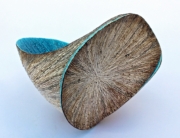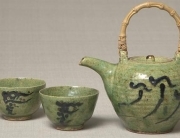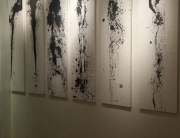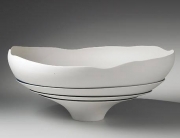History of Japanese Ceramics
first appearance in Japan is about 13 000 years. Pottery style Toryumon (applied with beans), which was updated in the cave Senpukuji (city of Sasebo, Nagasaki Prefecture), is the oldest existing pottery and is considered e as the starting point of Yakimonos Japanese culture, a culture that has survived continuously until today. We present in this paper how the culture Yakimonos has developed from its origins to today, along with Japan and the Japanese themselves. 1) Antiquity
1-1 The Jomon period (145ième century – 10th century BC. JC)
The Jomon period begins there are about 16 500 years, extends over 10 000 years, and is divided into six eras: the Jomon incipient Jomon primitive, ancient Jomon, Jomon means the Jomon Late Jomon final. At this time, pottery of all shapes and patterns emerge almost on the whole territory of Japan, and ceramics grows continuously. This period of incredible length is half the history of Japanese ceramics in which this art has matured by itself without any outside influence. During the Jomon average creations with unique shapes and agrémentations rich and varied emerge one after the other, and will be recognized later as works of inestimable value, not only historically, but also an aesthetic point of view.
1-1-1 ornamentations and techniques
“Jomon” this name originated ornamentation. In fact, clay rings were stacked on top of each other and joined together by means of cords applied on the surface. After having done enough dry, the pottery was fired at a temperature of about 600 degrees. These patterns proved to be excellent decorations and developed on a wide range of variations: ornamentation made using clay reliefs applied to the surface , elaborate designs using fingerprint shaped human nails, tools such as shells or bamboo are Played to provide compositions in complex layouts. The introduction of basketry and specific reasons such as humans, snakes or frogs are characteristic of the time. During the final Jomon, decorations vermilion or rust staining (due to the high iron content of dyes) have also been observed.
To reduce cracks occasioned during or narrowing of the drying process, in which pottery mixing plant fibers make their appearance, testifying to the ingenuity the people of the Jomon period.
1-1-2 Ceramics decorated with flames
During the Jomon medium (about 5 500-4 500 years before present), whose objects of worship “Dogu” (terracotta statues) were created in large quantities, and this was also the appearance of the ceramic flame patterns representative of the Jomon period. It takes the form of hollow jars but dynamic decorations that recall the heat of the fire that burns are suppose they were used in religious rituals. The transition from nomadic to a sedentary lifestyle and increasing the size of the stand, allow the enrichment of cultural life and the appearance of ceramic art and rich unique not only to fulfill practical functions. Ceramics that have been updated in Niigata Prefecture obtained the status of national treasure in 1999, and their high aesthetic quality still influences many Japanese artists.
1-2.La Yayoi period (about 3rd century BC. BC – 3rd century AD.)
During the Yayoi period which saw the development of rice cultivation, enter the scene ceramics whose uniqueness and beauty of the shapes have nothing to envy to those of the Jomon period. Jars, vases and pots spread throughout the country from Western Japan, and allow better ways of living. The simple geometry and balanced harmony of form and ornamentation that does not start functionality, are evidence of a sharp and aesthetic contrasts with the primitivism.
The same time as rice, a new method of firing ceramics comes from China. Instead of cooking fireplace leaving the surface of the pottery discovered, the parts are then covered with straw and earth. The temperature is maintained at 800 degrees, which reduces the risk of cracks and allows rendering superior cooking.
1-3.The ceramics Haji and Sue Kofun period (3rd century – end of 7th century)
During the Kofun period following that Yayoi, two types of ceramics are made for utilitarian purposes, ceramic Haji perpetuate traditional techniques of the Yayoi period, and ce , Sue ramiques are introduced to Japan from the Korean peninsula. The two main differences between these ceramics are the form and method of cooking.
Haji ceramics were numerous especially in eastern Japan. With very few patterns and tan, she served as funerary jars or took the form of Haniwa. As for ceramics Jomon and Yayoi periods, they were given form by piling élongés pieces of clay, and cuissaient in oxidizing atmosphere.
Sue ceramics have been introduced since the Korean peninsula around the 5th century and spread mainly in western Japan. The accuracy of forms possible thanks to the potter’s wheel, the reduction permitted by cooking ovens “anagama” (over 1100 degrees), engendered black-gray color re sultant made cooking a more compact and more sophisticated forms. In fact, Sue ceramics were considered of a higher quality compared to ceramics Haji, by their high functionality and the interest of their conformation. For some of them, the ashes of cooking materials would be deposited on the part, and the chemical reaction caused created a natural glaze. The oven Suemura Osaka became the main manufacturing center. The ruins of the oven were found indicating a production that lasted more than 500 years.
From the 9th century, trade between Haji pottery style and style Sue grew and then saw appear in large quantities parts inheriting two techniques.
Cooking in an oxidizing atmosphere and reduction fired
Baking in an oxidizing atmosphere is a method of baking (800 to 1250 degrees) which carries a large amount of oxygen. For reduction firing, it is to plug the furnace chimney to enclose oxygen (cooking from 900 to 1250 degrees). Oxygen from running out inside the furnace, the organic materials trapped in the clay act as fuels and chemical reactions take place in the clay as well as varnish, allowing the creation of pieces whose beauty is the unpredictable. (This is called “yohen” or transformations in the oven).
ANAGAMA oven which is the original form of the reduction furnace for cooking, as a basis for noborigama kilns (ovens lying).
1-4 The early ceramic glazes, the Nara period Heian period (8th century – 12th century)
The second half of the 7th century saw the emergence in Japan of the first artificial glazes and ceramics Ryokuyu (* 1). At the same time, Sansai ceramics of the Tang Dynasty, brought from China after receiving influences from around the world, introduced in Japan. At the beginning of the 9th century, ceramics Kaiyu (* 2) that use cooking at very high temperatures (about 1240 degrees) and integrate ash plant are emerging, and the art of Japanese ceramics knows a considerable step forward.
Parts manufactured under the influence of the Tang Dynasty ceramics are Sansai why glazes containing lead white, green and indigo are prepared, which incl parts and these are fired at low temperatures (about 850 degrees). While in China, ceramics Sansai funerary objects are to be deposited in the tombs of the upper class in Japan, they have different functions, are used for ceremonial rites and Buddhist ceremonies or for everyday use.
During the Heian period, the porcelain of the Tang Dynasty, the celadon and Zhejiang province are imported. The trend toward Chinese porcelain strengthens, ceramics Ryokuyu the colors reminiscent of celadon grow more, and many parts are manufactured with the center region of the current Kyoto and Aichi Prefecture. For example, Sanage in Aichi prefecture, in its 500 furnaces in parallel manufactures ceramics and Ryokuyu Kaiyu and continues to grow for nearly 700 years.
Japanese potters, while drawing Chinese methods, but never simply imitate them, have improved their techniques and kilns, and ceramics created without interruption in harmony with the uses and lifestyles.
(* 1) Ryokuyu
Glaze high in copper, which produces green color transparencies.
(* 2) Kaiyu
Glaze that uses including as an ingredient in plant ash.
2) Changes in the art of Yakimonos, periods of Kamakura, Muromachi, Momoyama (late 12th century – mid 16th century)
2-1.The Six Fours Past: The Rise of furnaces Province
During the second half of the Heian period (late 12th century), at the same time as the reform of society, Yakimonos are changing dramatically. Replacing high quality ceramics for the upper class, are produced in large quantities of plates, bowls or large jars with simple style and unglazed called Yamajawan. In parallel with the development of ceramics for people of common birth whose most representative are those of Atsumi and Tokoname (Aichi Prefecture), provinces furnaces were erected one after the other in western Japan. Structures independent productions and away from the center of political power that is Kyoto, made their appearance in the provinces causing the rise of a new culture.
Among them, 6-producing regions Seto-yaki, Tokoname-yaki (Aichi), Shigaraki-yaki (Shiga Prefecture), Echizen-yaki (Fukui Prefecture), Tanba-yaki (Prefecture Hyogo) and Bizen-yaki (Okayama Prefecture) – continued to produce seamless until today and are called “Nihon Rokko Yo” or six old kilns of Japan.
Ceramics valuable for the upper class continued to be produced in the current prefecture of Aichi. This is where ceramics are born Seto and Mino. It is said that Kato Shiro Zaemon Kagemasa (also called Toshiro), considered the father of ceramic techniques brought from China which has encouraged the development of these ceramics .
Thus Seto, in conjunction with the Yamajawan for the civilian population, are produced precious porcelain for the nobility, utensils for tea are also beginning to be made and the area became a center of considerable magnitude for creating ceramics.
The Bizen-yaki (Okayama Prefecture) recognized for rendering enabled by a particular soil, are also emerging at that time. The Bizen-yaki that time are placed in line ceramics Sue, and are coated with a varnish Kaiyu. Subsequently, they developed more along with ceramics for tea, to lead to a compacted earth style and unglazed we know today.
At almost that time of large furnaces, has the Muromachi period (14th century) when the province furnaces are two distinct pathways: the abandonment or the continuity and expansion.
2-2.The e development of the tea ceremony and its ceramics
The tea ceremony is revolutionizing aesthetic and allows the introduction of new techniques in the world of Yakimonos. The custom of “drinking tea” which already had a popular craze around the 12th century, takes off during the Muromachi period with the arrival of China utensils for the tea ceremony, and during the Azuchi Momoyama period (second half of 16th century), the excitement reached its peak.
The tea ceremony sessions between military officers during which the works are subject to assessment being common, and ceramics used for tea serving policy incentive daimyos (feudal governors) to their vassals, Yakimonos, along with the tea ceremony, are tools of power in the political world.
In addition, placing themselves in opposition against the tea ceremonies and lavish lush tea a school called “wabicha” which attaches importance to the spiritual aspect , is gaining popularity among the commercial classes and ceramics marked specific character are made in various regions.
furnaces Seto and Mino,
new Yakimonos called “Seto-guro”, “Ki-Seto”, “Shino”, “Oribe” make their appearance, and high quality ceramics are made large quantities.
The Seto-guro bowls are in the form of a half-cylinder covered with jet black glaze. Ki-seto among the many people that are coated with a green glaze mainly due to a yellow glaze and chalcantite (ingredient glaze made from copper sulphate).
In the second half of the 15th century, the passage of the ovens ANAGAMA “Daigama” (ovens built partially or entirely above ground) is a revolution in Technical ovens. It is in these furnaces Mino where high temperature baking is now possible that during the second half of the 16th century, appear Shino, ceramic raw white of Japan for which patterns are drawn using a paint based on iron “Chosekiyu” (feldspathic glaze), which is only possible with one cooking high temperature. Similarly, Oribe colors to vivid greens, and unique shapes and patterns are also emerging.
Kyoto , the Raku-yaki emerge. Under the direction of tea master Sen no Rikyu, tea bowls Raku type are created by Chojiro I. The particularity of Raku-yaki is a hand massage and a cooking method that creates rustic forms. After a low temperature cooking taking place in “Uchigama” ovens small sizes, bowls coated with a glaze of lead are removed from the oven and cooling suddenly gives birth to very specific colors. The Tamamizu-yaki Kyoto or Kanazawa Oohi-yaki are in the line of Raku-yaki.
A Shigaraki and Bizen , are manufactured Yakimonos whose characteristics are a compact touch ground after cooking and no glaze. These “Shimeyaki” (unglazed stoneware ceramics) that are used mainly in the production of pots, jars and mortars were used at the time for everyday use, but along with the growing craze for Wabicha, they became the center of attention in the context of the tea ceremony.
Karatsu-yaki to make their aparition Kyushu in the second half of the 16th century. They thrive on the basis of other cooking methods and techniques from the Korean peninsula and the region of Karatsu quickly became known as the land of production glazed ceramics. The “noborigama” (dragon type ovens coated) made possible mass production due to their large size and thermal efficiency, and production of Karatsu-yaki is much higher dimensions. Techniques “tataki”, “zogan”, “kerirokuro” are adopted. While in the early days inpirant bowls Goryeo on the Korean Peninsula and Mino ceramics are produced tea utensils or tableware simple, but eventually they will be ornamented , s underglaze decorations using ferrous pigments, and the particular style that uses enamel Chosekiyu will emerge. Thus the appellation of Karatsu-yaki went up Yakimono become synonymous in western Japan. The oven system “Renboshiki” (multi-chamber) that did not previously exist in Japan, spread throughout the country starting with Mino, but Takatori (Fukuoka Prefecture) , Satsuma (Kagoshima Prefecture), Yatsushiro (Kumamoto Prefecture), Ueno (Fukuoka Prefecture), Hagi (Yamaguchi Prefecture), Inbe (Okayama Prefecture), allowing Japanese kilns to develop further.
2-3.The origins of china
The discovery of clay to porcelain: Arita and Imari
Japanese porcelain was initiated in 1610 in the town of Arita, Saga Prefecture. The artist potter Ri Sampei, brought to Japan during Toyotomi Hideyoshi’s campaign in Korea, discovers the materials necessary for the manufacture of porcelain quality upstream of the River Arita, and successful cooking. It is from this point that the Arita kilns are expanding rapidly. Because Arita porcelain made are transported across the country from the nearby port of Imari, they are known and appreciated as the Imari-yaki. They are also called Hizen Arita-yaki or yaki.
Arita porcelain made during this initial period is commonly called original Imari. Sometsuke technique which consists in tracing designs on the body part using safre (dark blue pigment), coating a transparent glaze over and finally cooking part is widely utlisée.
The appearance of colored patterns
In 1640-1650, the Imari-yaki are the subject an important technical revolution. The system knows a mutation ovens large and I Sakaida Kakiemon porcelain designs patterned with red color base. In this continuity, the grounds gorgeous porcelain emerge one after the other, and Arita has a period of great popularity. Patterned porcelain then divide into four styles as outlined below.
Kokutani style is so called because it is said to have emerged in furnaces Kokutani in Ishikawa Prefecture, but in archaeological research, the prevailing thought is it is strict adherence to original porcelain of Hizen and Arita.
For many large plates are the original designs, each model is unique. The technique is to combine Sometsuke and patterns to color red is called Shonzuide; patterns representing characters or landscapes (Kachofugetsu) painted in shades of black, green, purple, blue and yellow Gosaide are called, and AODE is to cover the front surface of a thick green or yellow.
Kakiemon style was established, as its name indicates, Sakaida Kakiemon, and was produced primarily to be exported abroad. Onto a milky white, polychrome patterns with red as the base color, depict scenes such as landscapes (Kachofugetsu) while leaving a significant gap between the hand motifs.
Around 1710, starting with the oven Meissen in Germany who managed the porcelain firing for the first time, Sèvres in France, England or Chelsea, many foreign countries is trying to imitate. In furnaces Keitokuchin considered the land of birth of porcelain, “Chinese Imari” strongly influenced by Arita, are manufactured and exported to Europe.
Ko-Imari style (old Imari) is a technique of deep blue Sometsuke whose production began around 1690 and uses retained without gold or red pigments called s Gozai or Kinrande.
To replace Keitokuchin has ceased export in 1659, the Dutch East India Company gained control Arita for mass production of porcelain for export to Southeast Asia and Europe. In order to take into account the taste and modes European brocade effect (“Nishikide”) that finds the decorative quality is developed. It easily meets European demand and the product quickly became the most popular export porcelain.
The effect brocade (“Nishikide”) is to paint over the additional grounds Sometsuke porcelain, and bake parts at low temperatures. The Nishikide over which we have also added some golden colors are called “Kinrande.”
Nabeshima style said patterned porcelain produced in kilns directly administered by the Nabeshima clan who gourvernait Arita region. It is a decoration or produce gifts for daimyos. Among them we can find Iro-Nabeshima, which combine technical and Sometsuke colors red, green and Beus, Ai-Nabeshima Sometsuke to extremely fine, and the bluish celadon glazes Nabeshime , s of great beauty.
expansion porcelain
In the second half of the 17th century, Arita decided to focus more on the domestic market within and through the production of numerous utensils for daily use with Sometsuke as technical main porcelain also spread among the population. In the 18th century kilns producing porcelain are established in various regions such as Kyushu, Kyoto Prefecture Ehime (Tobe-yaki), the prefecture Fukuoka (Sue-yaki), Miyazaki Prefecture (Komine-yaki), or the Shimane Prefecture (Ito-yaki). During the second half of the 18th century, Seto successful cooking Sometsuke, leading to the rapid increase in the quantity produced, and bypassing land of birth porcelains, Arita, in the East Japan, the term is up Setomono become synonymous Yakimono.
3) The new trends of the period Meiji, Taisho, Showa, until today (from 1868)
3-1.La Meiji Restoration and relations with Western Europe.
The Meiji Restoration was a wind of change in the world of ceramics. Trade with Europe and the United States are increasing, and influence by technical inputs beneficial in one way or another. Under the motto of the government encourages the establishment of new businesses and promotes prosperity and military strength, a lot of decorative ceramics are produced to satisfy foreign demand and furnaces Meiji period taking gigantic proportions as to be able to support the national public finances.
To promote technical advances in the art of ceramics, the government invited technicians from the United States or Western Europe, to stay in Japan. The German scientist Gottfried Wagner (1831-1892) among others is invited to Arita in 1870, and thanks to its technical ceramics related to tender (* 1), cobalt oxide (* 2), and coal oven (* 3), it has a great influence on the artists of Meiji.
Under government guidelines, and to increase exports, a sytème of operations division which deals separately making materials, and application patterns, is implemented. Modeling the shard (* 4) takes place in the province such as ovens or Arita Seto, and specialized workshops in the decoration are built in cities near export ports such as Tokyo, Yokohama, Nagoya and Osaka. Ukiyo-e artists (* 5) who had lost their jobs after the Meiji Restoration, become ceramic painters (* 6), and provide day many artworks to lavish ornamentation. In addition, in Hyogo Prefecture (Izushi-yaki), Nagasaki Prefecture (Mikawachi-yaki), Arita, Mino or Satsuma vases decorated with sumptuous large are made which were a great success when presented at international expositions in Paris (1876), San Francisco (1871) and Vienna (1873).
Thanks to the export activities of ovens, Yakimonos spend a Japanese artistic design that proclaims the supremacy of simplicity aesthetic ornamentation rich and flamboyant shapes inspired Western such as ceramics or Chinese Qing Art Nouveau.
In addition, the end of the Meiji period to the Taisho period, emerging ceramic artists developing unique aesthetic visions. Talented artists such as Itaya Hazan (1872-1963) who devotes himself to the study of porcelain ornaments, Numata Ichiga (1886-1963) who after staying in France Sè ; lips in porcelain factories, and studied under Rodin explored the field of ceramic sculpture, or Tomimoto Kenkichi who, after studying architecture and decoration integrated , rieure and a stay in London, developed the unique ornamental plants, are entering the scene ceramics, and contribute to the search for new opportunities to ceramic art that expresses personal aesthetic visions.
3-2.The Mingei movement
Mingei movement (literally the movement of popular arts and crafts) was born in 1925 thanks mainly to the philosopher Yanagi Soetsu (1889-1961). The term “mingei” is a neologism created by Yanagi and Shoji Hamada potters and Kawai Kanjiro and refers pieces from folk art. Rather than works born of the desire of artists, it is objects for everyday people. The Mingei argues that precisely because it is works made by craftsmen ordinary beauty they contain essential to human life. The Mingei rediscovered and collects ancient art forms born of customs and traditions, aiding recovery techniques obsolete, and promotes a new style craft that integrates gre traditions to contextualize contemporary, thanks to the support of individual artists who were also leaders of the movement.
Many artists such as ceramic artist Bernard Leach who made his career in England and Japan, Kawai Kanjiro, Hamada Shoji, but also the artist Keisuke Serizawa textile, participate in the movement and encourage the spread of Mingei thought throughout the country, thought through which the articles for daily use in various regions, it is not too much to say that they were all completely unknown to (dyed textile, paint on wood, painting, goldsmithing, stone or wood) are the subject of research and introduction to the public. From production areas that attract the most attention are Mashiko (Tochigi) Koishiwara (Fukuoka), Onta (Oita) Aizuhongo (Fukushima) or Tsuboya (Okinawa).
Soetsu Yanagi founded the Museum of Popular Art Japanese server for basic operations, also publishes the magazine “Kogei” (ancestor of the magazine “Mingei”) and works hard to release publicly the results and the direction of his quest. Soon, the concept Mingei penetrates the minds enegendrant many supporters, upsetting the thinking of the world of crafts far divorced from practical use, and exerted a lasting influence on modern Japanese crafts.
Kawai Kanjiro (1890-1966), thanks to trade with Yanagi and Hamada, transformre decorative style has been evolving techniques of ancient Chinese ceramics and Korean pieces to powerful respecting the idea of ??practical use expressed by the Mingei.
Bernard Leach (1887-1979) and Shoji Hamada (1894-1978) whose trade predate the Mingei movement, build an oven set noborigama in St Ives, England, where they engage in their artistic activities. Subsequently, Leach works to spread the Mingei in England also, and opens new avenues for ceramic modern English. About Hamada, he set up a workshop in Mashiko, conducting research on land area and glazes, and greatly favors the development of ceramics in Mashiko.
3-3.Héritage and Future
While the world of ceramics evolves under the effect of new influences such as the Mingei movement in 1927, a ceramic section is introduced in the Art Exhibition of the Ministry of Education, Culture, Sports, Science and Technology (* 9), public competition (which become “Nitten” thereafter), whose purpose is to encourage the development arts, and many talented artists whose charisma leads the world of ceramics such as Kiyomizu Rokuwa Showa (Kiyomizu Rokube VI) Kusube Yaichi (1897-1984) or Kako Morino (1899-1987) made their appearance.
The classics are revived day. With enthusiasm for the art of tea from the second half of the Meiji period, or the economic crisis following the First World War, it is now possible to see Many renowned antiques from China or Japan, which had not been previously exposed in public, and in doing so, ancient ceramics such as Shino, Seto, Mino, Karatsu, Hagi are placed again at the center of attention. Arakawa Toyozo (1894-1985), Taroemon Nakazato XII (1895-1985), Kato Tokuro (1898-1985), Miwa Kyusetsu (1895-1981), undertake research in areas of origin in order to discover and reproduce the secret techniques of modeling and glaze. However, far from leading to a simple imitation of the past, it allows a unique artistic expression and individual to develop further.
In 1948, a movement was set up that opposes the idea of ??”beauty in the functionality ‘of force to this day. Suzuki Osamu (1925-2001), Yagi Kazuo (1918-1979), Yamada Hikari (1923-2001) established the company Sodei Ceramic Artists Association of Avant-Garde, whose goal is to find a new form of ceramic art which does not depend on the traditional heritage. For example, the work of Kazuo Yagi “The Ballad of Samsa” embodies the idea that the potter’s wheel, hitherto regarded as essential in extension of the body of the potter, is really just a tool for artistic expression. This work was later event in the world of ceramics and is ironically called “decorative-yaki”. However, this work does not seek to deny the legacy of tradition, but to question the nature of ceramics, mode of expression permitted by the pottery, and speaks of the reality of artists when facing the creative process. The influence exercised by the Company Sodei that extends to the present day, is akin to contemporary art and its possibilities are used in various fields such as expression ceramic murals, monuments and architecture.
The yakimonos, the materials themselves are holders of a strong identity while adorning our meals and our lives have evolved along with the times, and diversified in parallel with the lifestyles and values. Artists who know how to use the charms of earth and fire, multiply the challenges, attempts and failures, create new forms both technically and conceptually, and link with 12 000 years of history. Legacy and future for artists who can connect these two elements, the possibilities are endless creative innovations, and the key to these new forms of expression can not fault ê , be found in the tradition.
(* 1) Ceramics soft
Ceramics fired at low temperatures. This is the case of ceramics in Europe or Raku-yaki.
(* 2) Cobalt oxide
Colors for ceramics takes shades of blue after cooking. It can be used for placing the decoration, as glaze, or be mixed directly with clay. It is apparent that safre, but is less expensive.
(* 3) Four coal
Furnace using coal as fuel. More stable than wood, however, it is hardly used in Japan due to problems of pollution it generates.
(* 4) Tesson
Are parts after molding and before cooking. Talking about cookie to identify the part that has been cooked at a low temperature once before installing the decoration or glazing.
(* 5) Ukiyo-e Artist
Painter like “Ukiyo-e”, a genre that was born during the Edo period.
(* 6) Painter on ceramic
Artist specializing in painting on ceramic or ceramic murals.
(* 7) Ceramic Qing
Ceramics of the Qing Dynasty, the last imperial dynasty to have ruled China (1644-1912).
(* 8) Art Nouveau
International art movement with the center of Europe, which had its heyday between the late 19th century and early 20th century. Art Nouveau is applied in various fields of ceramics, metalwork, stained glass, but also in architecture and graphic arts.
(* 9) Art Exhibition by the Ministry of Education, Culture, Sports, Science and Technology
Competition scale established by the Ministry of Culture. It is the largest national art association, which, in appellations which vary over time, “Teiten” Shimbunten “,” Nitten “leaves its mark in the history of art Japan.






